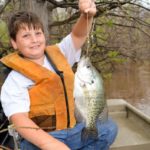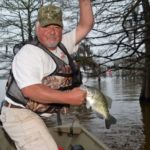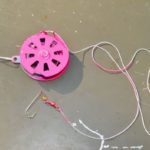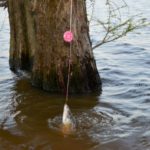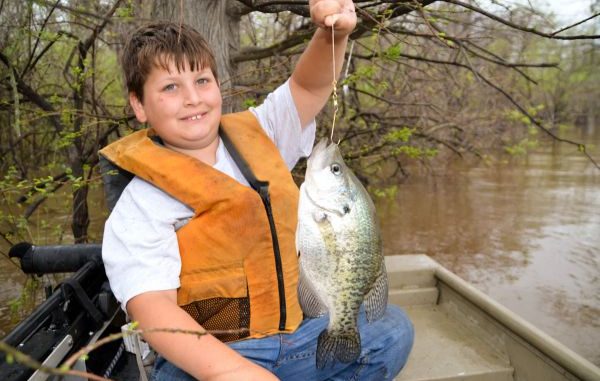
Even if winter rains make turn the waters of the Saline-Larto complex into a muddy mess, there are fish to be caught — and these anglers know that yo-yos are sure to fill their ice chests.
It all began with a photograph.
Amber Bordelon sent it to Louisiana Sportsman magazine to see if they would print it. It looked like an avalanche of sac-a-lait, catfish, and bream.
It knocked my eyes out.
I called her to get the story on the photo. Ultimately, I was hoping to finagle a trip with whoever was able to catch that many fish.
She explained that the fishermen who caught the fish were her father Arthur Manuel of Dubon (then aged 50) and her son Tyler Bordelon (age 8), who lived with her in Marksville. She gave me her dad’s phone number.
I called Manuel. Although he was slow-talking (I felt that I had to drag every word out of him with a come-along, one word at a time), he was friendly and seemed willing to take me fishing.
But the water wasn’t right. Could I call later?
The next time I called, the camp needed work. Could I call later?
I called again, but he told me he was too busy to fish.
On the next call, I was told that the best fishing was over for the year.
Not being one to give up easily (I really wanted this story), I went through the same routine the next year, with the same results. In retrospect, I guess most people would have figured out by then that Manuel wasn’t interested in some outsider tagging along on his fishing trip but was too gentlemanly to tell me that outright.
Not me. I called again in year 3.
To my surprise, he said, “Come on.”
Maybe I wore him down, or maybe he just took pity on me.
Whatever: His invitation launched me on the road to Saline Lake, part of the Saline-Larto complex — the fabled land of white perch fishing.
This is Central Louisiana, but with South Louisiana influences. Manuel and Bordelon used the terms white perch and sac-a-lait interchangeably for the species properly called crappie.
I hung a left in the tiny Rapides Parish crossroads town of Deville, passed a kink in the road called Big Island and rolled on to a small camp community at Open Bayou Landing.
I was early, so I waited. At 3:15 p.m., a dusty pick-up truck rolled up and my two caballeros dismounted.
Manuel, a tad on the roly-poly side, sported prematurely silver hair, a neatly trimmed Vandyke beard and a permanent smile. He was already heavily tanned, although summer wasn’t here yet.
“If I don’t have to be inside, I’m outside,” was how he explained his tan.
Grandson Tyler Bordelon was now 11 years old and almost as tall as his pawpaw, who is 5-foot 5-inches “with my heels on,” he joked.
Young Bordelon sported a big Leave it to Beaver grin and looked like he just stepped from the cast of the Little Rascals. He was unfailingly polite, and obviously adored his grandfather.
At their camp on the banks of Open Bayou, the ultra-slow-talking Manuel organized things with deliberation — in spite of the late hour in the day.
“It don’t pay to rush,” he drawled.
He laid out their plans while he worked.
“We’re going to do our routine: set and bait our trotline, and then put out a few yo-yos,” Manuel said. “We can always get a good mess of fish on our trotline and yo-yos, even if the fish don’t bite too good on our rods and reels. We’ll hang two dozen yo-yos. If they are biting, that’s all we’ll need. If they aren’t biting, four dozen won’t help.
“When we fish with rods, we like to fish shiners under corks, old-style, and we fish near cypress trees when they bud out in the spring. We’ll use jigs, too, but mainly in the winter.”
Their trotlines were designed for success.
“Our trotline has 25 hooks and we bait with shiners, live ones hooked through the tail and dead ones through the head,” Manuel said. “In the last 6 weeks we caught at least 200 pounds of catfish.”
“Pawpaw, we caught a 22-pounder,” Bordelon reminded his grandfather.
Finally Manuel declared that we were ready to go. From Open Bayou, it was a short jog to Big Creek, which in turn ran into Saline Lake. Our destination to set the yo-yos was near a point where Nolan Bayou enters the lake, although on the run Manuel nodded that yo-yo fishing in Big Creek was good too — “all the way to Woodson’s Landing.”
The lake was disappointingly muddy. Rising spring river waters feed through the Diversion Canal into the lake. In this kind of water, fishing with a jig pole or a rod and reel would be a waste of time.
But Manuel declared that rising water levels could be to our advantage.
“It makes it easier to get near the shoreline to set our yo-yos,” he explained.
Before hanging yo-yos, Manuel ran the boat across the lake to set their trotline, a premade “store-bought one,” he drawled almost in half-apology for not having made his own.
They strung the main line between two standing cypress trees and hung a scrap-iron weight midway along its length to take the line underwater.
Setting the yo-yos took coordination, and each knew his job. Manuel held the boat steady, pointed upwind with its bow into the tree; Bordelon hung each yo-yo from a limb, baited the hook, stripped out the line and set the trigger.
Bordelon had a twiggy job. He got twigs, Spanish moss and assorted tree debris in his hair, ears, and eyes. Some went down his collar, about which he offered advice.
“Wear a loose shirt,” he said. “All of the twigs that go in the top of the shirt go out of the bottom — unless they get stuck in your pants. Then you do some digging.
“Don’t wear loose pants.”
It’s obvious why they use a small, maneuverable boat in the tight quarters under the trees, but the youngster wanted to make sure I didn’t miss anything in my notes.
“I can tell you why it’s better to have a little boat: We used to have a big boat and my face was always in the branches,” Bordelon explained. “Them branches tear you up.”
As Bordelon was baiting the hook on the last yo-yo in the bucket, the yo-yo set just before the one in his hand clicked and whizzed as a fish — a nice white perch — struggled vainly to escape.
They ran that yo-yo, and then another one two yo-yos up the line brought a flouncing 1-pound catfish up.
As they moved up the line of 24 yo-yos, they found several were sprung with the bait missing. They rebaited as they went, some with shiners and some with a piece of cold worm.
Looking ahead, Bordelon became excited.
“Look Pawpaw, there’s a fish, and there’s another one — both catfish,” the young angler exclaimed.
As they were unhooking the second of the pair, another yo-yo clicked and went to work, this one on a fine white perch.
It seemed like one fish followed the other. I began to lose count.
“These are some of he best-eating fish you have ever tasted,” Manuel muttered with satisfaction.
“Why?” I innocently asked.
As usual, the answer man, Tyler Bordelon had a reply.
“When you are hungry, any fish tastes good,” he said. “Any fish is good.”
A big smile beamed on his face.
Even though the yo-yos were mauling the fish, Manuel tore away from them to check the trotline. It only held one catfish, but all the baits were gone.
They rebaited, half with shiners and half with cold worms.
“We’ll go to the camp and eat, and come back after dark to run the hooks again,” Manuel shared. “We won’t rebait the yo-yos again after that run because the ants will get them overnight. No sense wasting fish.”
Every tree seems to be home for a thriving ant colony, the members of which have no qualms about descending a yo-yo string to munch on any fish too small to keep its head underwater.
Manuel swung back by the yo-yos on the way to the camp.
“I see a fish,” the sharp-eyed Bordelon announced well before we got there. “I see another one, and another and another.
“Hey, I see one way over there.”
The pair worked quickly as daylight rapidly skidded into dark. Back at the camp, Bordelon’s mother Amber was waiting for us.
She wasn’t just checking on us; she brought supper—a carnivore’s delight of humongous ribeye steaks, smoked venison and pork sausage, and hoghead cheese to snack on while the other meat cooked.
We ate quietly outdoors on a picnic table in the penumbra of the camp’s porch light, serenaded by early spring crickets.
Much to Bordelon’s chagrin, plans to run the yo-yos after supper were torpedoed by lightening-bearing storm clouds.
We woke at 4 a.m. to a gentle rain, accompanied by distant thunder. Manuel prefers to run his yo-yo’s once before daylight, but this day we drank coffee and waited out the rain, finally leaving the camp shortly after daylight.
“We got fish,” Bordelon declared as we neared the yo-yos.
Heads were visible under a lot of the yo-yos. The youngster went to work unhooking fish and rebaiting yo-yos.
When he wasn’t full of answers, he was full of questions.
Mr. Jerald this, and Mr. Jerald that. He was particularly interested in how notes turned into a fishing story.
“When Pawpaw told me a writer from the Sportsman was coming, I didn’t think that you would be a regular person. I thought you would be strict and all that,” he said.
I was flattered.
After taking three fish off of six hooks, there was a run of six more yo-yos that were sprung and baitless.
“Tyler, I’m looking at four fish coming up,” Manuel said softly.
It was three channel catfish and our first blue cat.
It was a calm, damp morning — no wind. Woodpeckers drummed on hollow trees and birds yodeled their courting songs out over the water. It was peaceful, only interrupted by the sound of Manuel constantly dropping the lid of the ice chest after Bordelon chunked another fish into it from the bow.
That run yielded nine catfish. As Bordelon baited the last yo-yo, a catfish tripped one three hooks back. It was fun watching the fish’s futile struggle. Anyone who didn’t enjoy this, just doesn’t enjoy fishing.
The return run produced five more catfish and two sac-a-lait. We could hardly leave the yo-yos to run across the lake to check on the trotline, but we did.
The results were disappointing — a lone gaspergou.
“We are going to have to move it close to the bank this afternoon,” Manuel said in a low voice. “The water is rising.”
The next run of yo-yos gave up as many sac-a-lait as catfish, an impressive feat in the chocolate soup muddy water.
Manuel paused the boat partway through the run. It was a real kick, floating quietly and seeing fish come flouncing to the surface, fighting the tension of the yo-yos.
This run also yielded a largemouth bass.
“Take that, tournament fishermen,” Bordelon shouted as he grabbed the line. “They turn their fish in; the only fish I turn in is into the grease.
“You eat a fish when you catch it.”
His bright blue eyes sparkled. He was proud of himself.
All too quickly, Manuel called a cease-fire.
“You put any more fish in that box, Tyler and I’ll have to step on it,” he said.
It was only 9 a.m.
